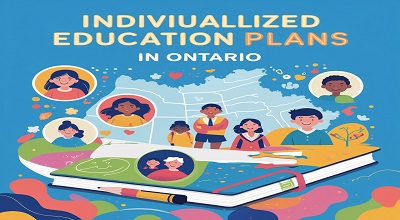Individualized Education Plans
In Ontario, Individualized Education Plans (IEPs) are essential tools designed to support students with special education needs. These plans ensure that every student receives tailored instruction and accommodations to help them succeed academically, socially, and emotionally.
The Ontario Ministry of Education mandates that school boards provide IEPs for students who require modifications or accommodations to meet their learning goals. This guide explores the latest policies, examples, and best practices for IEPs in Ontario as of 2024.
What Is an IEP?
An Individualized Education Plan (IEP) is a written document that outlines:
- A student’s strengths, needs, and learning goals.
- Specific accommodations, modifications, and support services.
- Strategies for teachers, parents, and support staff to help the student succeed.
Unlike a standard curriculum, an IEP is customized to fit the unique needs of each student, ensuring equitable access to education.
Legal Framework and Policies Governing IEPs in Ontario
IEPs in Ontario are governed by several key laws and policies:
- Education Act (Ontario) – Requires school boards to provide special education programs.
- Ontario Human Rights Code – Ensures equal access to education for students with disabilities.
- PPM No. 140 (Policy/Program Memorandum) – Mandates IEPs for students with special needs.
- Accessibility for Ontarians with Disabilities Act (AODA) – Promotes inclusive education.
School boards must follow these regulations to ensure compliance and student success.
Who Needs an IEP?
An IEP is developed for students who:
- Have a learning disability (e.g., dyslexia, ADHD).
- Experience developmental delays (e.g., autism spectrum disorder).
- Have physical disabilities (e.g., visual or hearing impairments).
- Require behavioral or emotional support.
- Are gifted and need enhanced learning opportunities.
Identification Process:
- Referral – Teacher, parent, or specialist identifies a need.
- Assessment – Psychoeducational or medical evaluations.
- IEP Meeting – Parents, teachers, and specialists collaborate.
The IEP Development Process
Creating an IEP involves multiple steps:
- Student Assessment – Gather data on strengths and challenges.
- Team Collaboration – Teachers, parents, and specialists contribute.
- Goal Setting – Define measurable academic and behavioral objectives.
- Strategy Implementation – Assign accommodations (e.g., extra time, assistive tech).
- Documentation & Approval – Finalize the IEP and share it with stakeholders.
Key Components of an IEP
A well-structured IEP includes:
| Section | Description |
|---|---|
| Student Information | Name, grade, disability, strengths, needs |
| Learning Expectations | Modified or alternative curriculum goals |
| Accommodations | Supports like extended time, speech-to-text software |
| Teaching Strategies | Differentiated instruction methods |
| Assessment Methods | Modified tests, oral evaluations |
| Transition Plan | For post-secondary education or employment |
Examples of IEPs in Ontario
Example 1: IEP for a Student with Dyslexia
- Accommodations: Audiobooks, speech-to-text software, extra time on tests.
- Goals: Improve reading fluency by 20% over the school year.
- Strategies: Multisensory reading programs (e.g., Orton-Gillingham).
2: IEP for a Student with Autism (ASD)
- Accommodations: Visual schedules, quiet workspace, social skills training.
- Goals: Increase classroom participation by using assistive communication tools.
- Strategies: Applied Behavior Analysis (ABA) techniques.
Example 3: IEP for a Gifted Student
- Accommodations: Enriched curriculum, advanced project options.
- Goals: Complete independent research projects in science.
- Strategies: Mentorship programs with subject experts.
Roles and Responsibilities in IEP Implementation
| Stakeholder | Role |
|---|---|
| Teachers | Implement accommodations, track progress |
| Parents | Provide input, support learning at home |
| Special Education Team | Assess needs, recommend strategies |
| Student (if applicable) | Self-advocate, participate in goal-setting |
Monitoring and Reviewing IEPs
IEPs are dynamic documents requiring regular updates:
- Progress Reports – Shared with parents every term.
- Annual Review – Adjust goals based on student growth.
- Parent-Teacher Meetings – Discuss challenges and successes.
Challenges and Solutions in IEP Implementation
Common Challenges:
- Lack of teacher training.
- Insufficient resources.
- Parent-school communication gaps.
Solutions:
- Professional Development – Training for educators.
- Increased Funding – More special education support staff.
- Digital IEP Tools – Streamline tracking and communication.
Latest Updates and Trends in IEPs (2024)
- AI-Powered IEP Tools – Automated progress tracking.
- Increased Focus on Mental Health – More social-emotional learning (SEL) goals.
- Hybrid Learning Adaptations – IEPs for online and in-person schooling.
Conclusion
IEPs in Ontario play a critical role in ensuring inclusive and equitable education for all students. By following best practices, leveraging technology, and fostering collaboration, educators and parents can help students achieve their full potential.
FAQs About IEPs in Ontario
1. Who qualifies for an IEP in Ontario?
Students with learning, physical, developmental, or behavioral disabilities qualify, as well as gifted students needing enrichment.
2. Can parents request an IEP for their child?
Yes, parents can request an IEP by contacting the school’s special education team.
3. How often is an IEP reviewed?
IEPs are reviewed at least once per year, but updates can occur more frequently if needed.
4. What’s the difference between accommodations and modifications?
- Accommodations change how a student learns (e.g., extra time).
- Modifications change what a student learns (e.g., simplified curriculum).
5. Are IEPs legally binding in Ontario?
Yes, schools must follow IEPs under the Education Act and Ontario Human Rights Code.
For more resources, visit teacheducator.com.
Free Here: Kayyo APK
